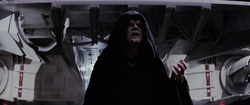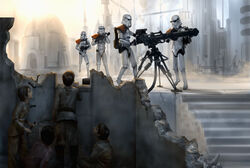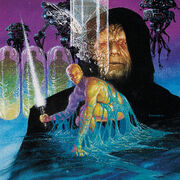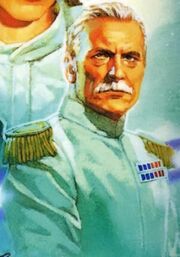The Republic, which had lasted for at least 25,034 years, ended following a period of intense political turmoil and the subsequent devastation of the Clone Wars. After General Grievous was defeated at the battle of Utapau, and shortly before the leaders of the Confederacy of Independent Systems were killed on Mustafar by Darth Vader, Chancellor Palpatine (by then ruling with near-absolute power), began a purge of the Jedi Order, and then proclaimed himself Emperor of the galaxy and reorganized the Galactic Republic into "the first Galactic Empire" on the galactic capital.
Contents[show] |
History Edit
Edit
Origin Edit
Edit
- "We stand on the threshold of a new beginning. In order to ensure our security and continuing stability, the Republic will be reorganized into the first Galactic Empire, for a safe and secure society, which I assure you will last for ten thousand years. An Empire that will continue to be ruled by this august body and a sovereign ruler chosen for life."
- ―Emperor Palpatine, in his Imperial Inaugural Address

Many people under the new Empire enthusiastically supported the vision outlined in the Declaration of a New Order, largely due to the violence that had plagued the galaxy for so long. Many Senators wholeheartedly supported the new government while a number of more cautious senators chose to watch and wait to see how the new government would handle the affairs of state. It promised to trade frailty for strength, chaos for order, and uncertainty for decisiveness. In retrospect, the foundation of the Empire had already been set down during Palpatine's chancellorship and all potential threats eliminated; therefore, the transition from Republic to Empire was relatively smooth.
It is important to note that not all of the Senators liked what they saw. In fact, the Petition of 2000 sought to bring the worries of these Senators to Palpatine. This petition was led by Bail Organa, Mon Mothma, and Padmé Amidala. Palpatine's dismissal of their concerns was one factor that led Organa and Mothma to help found the Alliance to Restore the Republic.
Imperialization Edit
Edit
- "I have brought peace, freedom, justice, and security to my new Empire!"
- ―Darth Vader

Nonetheless, many members of the Imperial military were unhappy about Palpatine's plans for imperialization: One Imperial officer, in particular, the headmaster of the Imperial Academy Gentis, who lost all but one of his sons to Palpatine's warmongering ways during the imperialization effort, formed a military coup against Palpatine and poisoned him with Aorth-6 as a means to bring peace to the Empire, something he realized that Palpatine would never pursue. The coup, while initially successful, ultimately failed.[10]
The Dark Times Edit
Edit
- "We must move quickly. The Jedi are relentless. If they are not all destroyed, it will be civil war without end."
- ―Palpatine
The Emperor saw the respected Caamasi as a threat to his New Order, so he ordered the devastation of their home planet Caamas. A group of Bothan infiltrators were responsible for sabotaging Caamas's shield generators, leaving the planet vulnerable to Imperial orbital bombardment. The once beautiful world was devastated during this attack, turned into a poisoned wasteland. The peaceful Caamasi were dispersed throughout the galaxy. In 18 BBY, the Emperor constructed the huge, asteroid-shaped superweapon Eye of Palpatine in order to use it to destroy a Jedi enclave on Belsavis. However, the deadly superweapon was sabotaged by two Jedi Knights and the Jedi on Belsavis managed to escape.
Around the same time, a group of beings were protesting the tyranny of the Galactic Empire on the planet Ghorman in the Sern sector. Wilhuff Tarkin's flagship was blocked by peaceful protesters who stood on the ship's landing pad and refused to move. With implied permission from Palpatine, Tarkin landed the ship anyway, right on the protesters, injuring and killing many. This came to be known as the Ghorman Massacre. The Alliance to Restore the Republic was founded in its wake.
Many Jedi also rebelled against Palpatine's regime. Olee Starstone and a group of Order 66 Jedi survivors along with Roan Shryne attempted to re-establish the Jedi Council but were unsuccessful. The group fled to Kashyyyk to find out if any Jedi survived there, but the Empire launched a massive takeover of the planet. Darth Vader killed Roan Shryne and some of the Jedi, with Starstone barely escaping with her life. A Wookiee among them, named Chewbacca, fled the city to find his family. Meanwhile, Ferus Olin along with his friends including Jedi Master Solace caused much havoc on Imperial-controlled planets including a rebellion on the planet of Bellassa, the two Jedi break-ins of the destroyed Jedi Temple on Coruscant, and the destruction of an Imperial Garrison and Weapon Munitions Center on Naboo. Also on Kessel, a group of Jedi including Master Tsui Choi and Jedi Knight Bultar Swan planned to draw Darth Vader into a trap and kill him. Due to exceptionally bad planning and tactics, every one of them was killed, though Vader's suit was slightly damaged.
In 1 BBY, the Emperor and Vader were the targets of an attempted coup by a group of treacherous Imperial officers led by Grand Moff Trachta. Trachta saw the Sith as foolish and archaic, and believed that the Empire should not be ruled by a two-man cult. They planned to use a batch of altered stormtroopers loyal only to them to destroy the two Sith Lords. However, their plot failed in part because of internal fighting between the co-conspirators.
Resistance to Imperial rule Edit
Edit
- "Listen, I can't get involved. I've got work to do. It's not that I like the Empire; I hate it! But there's nothing I can do about it right now. It's such a long way from here."
- ―Luke Skywalker to Obi-Wan Kenobi


A key instrument in the enforcement of the Doctrine was intended to be the Death Star I, a moon sized space station with sufficient firepower to easily destroy a planet with a single discharge of its powerful superlaser. Whereas many planets could afford planetary deflector shields capable of warding off virtually any conventional attack, none could defend against the power of that weapon. The weapon was destroyed in the Battle of Yavin, which marked the first major space-based victory for the Rebel Alliance. At this point Palpatine and the rest of the Empire realized that the Rebellion was a major threat to them and one that should be taken seriously, for the destruction of the Death Star was a massive blow to the Empire.
After the superweapon's destruction, the Rebels had finally found their footing. They began consistent strikes on Imperial-held territories, inciting continuing resentment against the Empire and taking them under the Rebels' banner. The Alliance had also cultivated renowned leaders and heroes as distinctive as Han Solo, Lando Calrissian and the Jedi-to-be Luke Skywalker. Although the Empire gained the upper hand in most campaigns against the Alliance (such as the Battle of Hoth and the construction of the second Death Star), they could not prevent the unstoppable juggernaut that the Rebels unleashed upon them and felt their grip in the galaxy slowly weakening. Thus, in the climax of the Galactic Civil War that was the Battle of Endor, the Empire was finally obliterated from the galaxy. Or so the Rebels thought.
Fracturing and warlord era Edit
Edit
Even prior to the fall of Emperor Palpatine in 4 ABY, the signs of fragmentation began to slowly reveal themselves as early as 0 ABY with the rebel's propaganda of the then recent Destruction of Alderaan. The first incursion was that of Moff Kalast, followed by the more serious situation involving the free-selling arms dealer Admiral Harkov, and finally culminating in the major Imperial infighting with Grand Admiral Demetrius Zaarin. The situation became serious when Zaarin attempted a coup d'état on Emperor Palpatine, managing to miraculously capture the Sith Lord by abducting him from his flagship, in a plot later thwarted by Admiral Thrawn.
Immediately following the Imperial defeat at the Battle of Endor, Grand Vizier Sate Pestage seized control of the Empire. However, he lacked the charisma, Force powers, and terrifying presence that both Emperor Palpatine and Darth Vader used to keep the Empire together. Admiral Blitzer Harrsk was the first Imperial to declare himself a warlord and set up his own mini-Empire, but he would not be the last. Others included Admiral Treuten Teradoc, Admiral Zsinj, and General Sander Delvardus, to name a few.
Sate Pestage only managed to hold the throne for a scant six months before he was deposed by the Imperial Ruling Council composed of three Tribunes. The Ruling Council was acting on the manipulations of Imperial Intelligence Director Ysanne Isard though, and the Ruling Council's leadership of the Empire ended under brutal conditions executed by Isard.
Ysanne Isard managed to hold the Empire together and stem off aggressive warlords, as well as Trioculus and the false Kadann, who also claimed the throne, for nearly two years before losing control of Imperial Center. When Ysanne Isard started to lose her grasp over the Empire, she had her scientists develop a biological virus targeting only nonhumans that she later let loose in Coruscant. So when Coruscant fell under the Rebel's attack, led by Rogue Squadron, they inherited Isard's disease that caused havoc for the starting government. With the loss of Coruscant, the Empire dissolved further and, soon, Warlord Zsinj was seen as the single largest Imperial threat in the galaxy. Isard managed to evade death and escaped to her own little kingdom.
The remnants of the Empire found themselves for the first time on the same side of the table as the New Republic. Both governments viewed Warlord Zsinj as their biggest threat. Zsinj came under the pressure of both governments, but it wasn't until Admiral Teren Rogriss teamed up with General Solo that they managed to bring Zsinj down.
The temporary alliance was over and new fighting erupted between the Empire and the New Republic over the scraps of Zsinj's domain. However, the New Republic dealt blow after blow to the Empire, winning most of the engagements and further humiliating the Empire by pushing them off of the monstrous ship producing world of Kuat.
Imperial resurgence Edit
Edit
- Main articles: Thrawn campaign, Operation Shadow Hand

The New Republic immediately took advantage of the Imperial power vacuum and moved to cut off future Imperial threats in the form of the remaining warlords. Using the pretext of pursuing Imperials who had committed various crimes the New Republic began their push against Prince-Admiral Delak Krennel. Despite Krennel's new ally in a clone of Ysanne Isard and the real Isard's machinations to steal back her Super Star Destroyer the New Republic emerged victorious and began pressing their advantage even more, leaving the Core worlds with minimal protection.
In 10 ABY, the surviving members of the Imperial Ruling Council, under Ars Dangor's leadership, gathered several belligerent Imperial warlords to organize a military campaign into the Galactic Core. The warlords were emboldened by the late Grand Admiral Thrawn's triumphs and accomplishments against the New Republic, which was still recovering from the devastating Thrawn campaign. The Republic was powerless to repel the military might of the once-more-unified Empire, and the Empire swiftly conquered much of the economically, politically and strategically vital Core Worlds within weeks. Chandrila, Esseles, Ralltiir, as well as the Metellos and Kaikielius systems, were seized by the Empire, while Caprioril was besieged by the Imperial Navy and the Borderland Regions were devastated. The offensive culminated in the decisive Fourth Battle of Coruscant, in which the New Republic abandoned the planet and the Empire retook the galactic capital. Having assumed total control over the Core Worlds, the Empire had been restored to its former glory, while the Republic leadership relocated its headquarters to the Outer Rim Territories.

Soon, an armed conflict broke out amongst the various political and military factions, each trying to dominate the Empire. The disarrayed Imperial Military was responsible for committing atrocities, massacring civilians and destroying entire worlds. Above Coruscant, the orbit became littered with space debris and the Star Destroyers conducted orbital bombardments, transforming the surface of the planet into a decaying urban wasteland. On the surface, stormtroopers, walkers and tanks fought on the streets of the planet-wide ecumenopolis. Much of the galactic capital was laid to waste, and millions of native Coruscanti perished during the Imperial infighting. The New Republic took advantage of the chaos, performing raids on Imperial territories through the use of captured Imperial vessels. The civil war ended only several months following the retaking of Coruscant.
Return of Palpatine Edit
Edit

The Emperor turned Jedi Knight Luke Skywalker to the dark side of the Force to serve as the new Supreme Commander of the Imperial Forces, but Skywalker defected back to the Republic and the astromech droid R2-D2 programmed the Emperor's awe-inspiring superweapons, the World Devastators, to destroy each other during the First Battle of Mon Calamari. In the Battle of Pinnacle Base, Palpatine summoned a Force storm to obliterate a Republic fleet orbiting Da Soocha V. However, Skywalker and his sister Leia Organa Solo used the Force, causing the storm to annihilate Palpatine and his flagship, the Eclipse-class dreadnaught Eclipse.
While Palpatine was presumably dead, the Shadow Hand Strategy was taken over by the Emperor's most powerful darksider, Military Executor Sedriss QL. Sedriss suffered heavy casualties in attempting to occupy the factory world of Balmorra and perished in the Battle of Ossus. However, the Emperor returned once again to spearhead his galactic conquest and commissioned his newest superweapon, the Galaxy Gun. The superweapon destroyed Da Soocha V, the Space City, Krinemonen and Hirsi, forcing numerous Inner Rim and Mid Rim worlds into accepting Imperial rule. The Empire had succeeded in conquering most of the galaxy and becoming the leading galactic superpower, while the New Republic was on the brink of downfall.
However, a group of Imperial politicians and officers, led by Carnor Jax and Sarcev Quest, sabotaged the Emperor's clone bodies in order to assassinate Palpatine and take control of the Imperial state. In the skirmish on Onderon, Emperor Palpatine's final clone body was killed and mortally wounded Jedi Knight Empatojayos Brand took the Galactic Emperor's spirit to the Netherworld of the Force. Following the Emperor's final demise, the Star Dreadnought Eclipse II was programmed to collide with the Galaxy Gun, destroying both superweapons. The Galaxy Gun accidentally launched a particle disintegrator warhead on Byss, destroying the planet and killing its inhabitants.
In these cataclysmic events, the Empire lost the Galactic Emperor, two superweapons, the Imperial Fleet orbiting Byss, and most of Palpatine's loyal advisors, officers, soldiers and Dark Side Adepts. The last major action of a Sith-led Empire, Operation Shadow Hand resulted in the final destruction of Palpatine's Empire, as the Destruction of Byss effectively terminated all political and military structures that upheld the Imperial state. Without the leadership and guidance of the late Emperor Palpatine, the Galactic Empire had practically ceased to exist. In the midst of chaos, rival warlords fled to their pocket empires, disorganized Imperial forces abandoned the Core Worlds, and the New Republic retook Coruscant. As a result, the resurrected Empire fell to its knees and self-destructed.
Death throes Edit
Edit
Following Palpatine's final death, Carnor Jax seized the Imperial throne. However, the Imperial fleet was left rudderless without orders from their Emperor. They retreated from the Core Worlds, and the Empire quickly crumbled. Many fleet commanders refused to follow the Jax and his Interim Ruling Council, and they broke away to form various warlord holdings. Jax's Crimson Empire thus held a small territory, limited to a narrow band of space that stretched from the Outer Rim to the Colonies.[11] It was the only territory still answerable to centralized Imperial control.[12] When Jax was killed by his fellow former Guardsman Kir Kanos,[13] the aristocrat Burr Nolyds took control of the Ruling Council.[14] He was soon killed by Nom Anor, an ally of Councilor Xandel Carivus who was aiding Carivus's plans to become the new head of the council.[15] Anor was secretly an advance agent of the extra-galactic Yuuzhan Vong species, and, unknown to even Carivus, he was targeting the council in order to hasten the Empire's collapse in advance of a massive Yuuzhan Vong invasion of the galaxy.[16] Carivus was elected the new head of the council,[17] but he soon disbanded the council and declared himself the new Emperor.[18] When the New Republic attacked his powerbase on Ord Cantrell and he was killed by Kanos,[19] utter collapse of Imperial authority followed, and the Empire ceased to exist.[20]
Legacy Edit
Edit
- "The whole galaxy's the front line now. We're not waging a full-scale war here, we're hitting the Republic anywhere we can."
- ―An Imperial officer at the Cairn Installation

While the warlords struggled in the Deep Core, Ambassador Furgan of Carida caused Admiral Ackbar's temporal retirement and poisoned Chief of State Mon Mothma to cripple the New Republic, which was recovering from Operation Shadow Hand. However, Carida and its prestigious Caridan Military Academy were destroyed by the Sun Crusher superweapon, piloted by rogue Jedi Kyp Durron, and Furgan himself perished during the Battle of Anoth, in which he attempted to kidnap Anakin Solo and brainwash the baby into a Force-sensitive Emperor. Meanwhile, the fleet under Admiral Natasi Daala's command was discovered in the Maw Cluster. Daala launched her guerilla campaign to overthrow the New Republic, attacking Dantooine and Mon Calamari. She also attempted to crash an Imperial Star Destroyer on Coruscant, but the plan was foiled by Durron and the Sun Crusher. Eventually, the Maw Installation, the Death Star prototype and the Sun Crusher were destroyed in the Battle of the Maw, and Daala was believed to be dead.
Following the Battle of the Maw Installation, Daala fled to the Deep Core and made contact with Supreme Warlord Harrsk. She allied with Grand Admiral Thrawn's second-in-command Captain Pellaeon, who now served High Admiral Teradoc, and together they gathered Harrsk, Teradoc, Delvardus, Yzu and the nine other warlords to an Imperial communications relay station on Tsoss Beacon. Daala's scheme to end the Imperial Civil War failed as the warlords refused to collaborate and organize a joint military campaign against the New Republic. Daala and Pellaeon assassinated the thirteen most powerful warlords with nerve gas, bringing their military forces together under the banner of the Empire.
The Imperial Reunification gave birth to the United Warlord Fleets. Under Daala's leadership, the fleets rebuilt the weakened Imperial Military by manufacturing countless walkers, starfighters and Star Destroyers, and even women and non-humans were allowed to work for the military. After Colonel Cronus, former second-in-command to Superior General Delvardus, joined the fleets, Daala seized the Night Hammer and renamed it the Knight Hammer. While Cronus committed lightning raids to Khomm, Porus Vida and the Chardaan Shipyards, Daala and Pellaeon attacked Luke Skywalker's Jedi Praxeum on Yavin 4, knowing that the New Jedi Order was the most dangerous menace against the Empire. However, the Battle of Yavin 4 was a military disaster for the fleets, as Pellaeon's fleet was pushed by Jedi Knight Dorsk 81 to the edge of the Yavin system, Cronus perished with his command ship, and the Knight Hammer fell into Yavin Prime. After the battle, Daala turned command over to Vice Admiral Pellaeon. Pellaeon, now Supreme Commander of the Imperial Navy, relocated the Imperial Remnant to the Outer Rim and annexed the Pentastar Alignment. The fortress world of Bastion, formerly known as Sartinaynian, became the capital of the new Imperial Remnant, and the Council of Moffs was established to succeed the Diet of Imperial Planetary Governors.
Several more defeats occurred over the ensuing years, forcing the Imperial Remnant into eight backwater sectors in the Outer Rim Territories. Seeing that defeat was imminent, Pellaeon finally admitted the need to sue for peace. After a peace accord was signed with the New Republic, the Remnant settled into a period of stability, thus ending the Galactic Empire's regime over the galaxy, after thirty eight years of Humanocentric dictatorship, opposed to Palpatine’s promising ten thousand year rule.
The Imperial Remnant's shift toward democracy did not last indefinitely. At some point after 44 ABY, the Remnant ceased to exist after its reorganization into a new Empire, ruled by a hereditary monarchy. Jagged Fel, the former Head of State who had attempted to reform the Remnant into a republican style of government in the first place, was crowned as the first emperor since Palpatine.
Government and politics Edit
Edit
- "Yeah, he says the Empire is the worst thing that ever happened to the galaxy. Dismantling every vestige of democracy, seizing assets, killing whole populations. He thinks I'm joining the bad guys."
- ―Biggs Darklighter to Luke Skywalker, speaking of Huff Darklighter

The Galactic Empire was actually more decentralized than the Galactic Republic. Systems were grouped in sectors and sectors in turn into oversectors. These were controlled by the Moffs and Grand Moffs, who exercised power in the disparate regions of the galaxy. This was in contrast to the structure of the Galactic Republic, which placed senators in control of their respective sectors. The planets of the Empire were no longer given a say in the government, but were now kept in line through fear of force.
Rulers of the Empire Edit
Edit
After being named Galactic Emperor in 19 BBY, Palpatine turned the sclerotic remains of the Galactic Republic into an empire and thus introduced authoritarian rule over the entire galaxy. Whereas before leaders had served for fixed terms until being succeeded by duly elected successors, now the thorny issue of Imperial succession complicated matters. For his part, Palpatine showed little real interest in the matter of who would succeed him – after Darth Vader lost some of his Force potential at Mustafar, Palpatine looked for ways to reign forever. However, his final death permanently put an end to his reign.
Palpatine was the sole legitimate and unquestioned Emperor to sit on the throne of his Empire, though Sate Pestage held the title in the interim during Palpatine's convalescence on Byss.
- Palpatine: 19 BBY[21]–4 ABY[22]
- Sate Pestage: 4 ABY[23]–5 ABY[24]
- Paltr Carvin, as head of the Imperial Ruling Council:[25] 5 ABY[24][26]
- Ysanne Isard:[27] 5 ABY[24]–7.5 ABY[28]
- Trioculus (self-proclaimed Emperor[29], in opposition to Ysanne Isard) (5 ABY)
- Impostor Kadann (self-proclaimed Emperor[29], in opposition to Ysanne Isard) (5 ABY)
- A coalition of Moffs and Imperial Advisors: 7.5 ABY–[30]
- Ars Dangor at the head of a resurrected Ruling Council:[31]–9 ABY[32]
- Grand Admiral Thrawn:[33] 9 ABY.[32][34] Additionally, the Ciutric Hegemony and the Pentastar Alignment, fearing coups, pledged their holdings to the Empire and to Thrawn, who was now in charge of a temporary military confederation.[35]
- A group of Moffs and Fleet Commanders:[36] 9 ABY[34]–10 ABY[37]
- Imperial Mutiny: 10 ABY[37]
- A resurrected Palpatine,[37] as leader of the Dark Empire:[36] 10 ABY[37]–11 ABY[11]
- Carnor Jax,[11] as leader of the Crimson Empire:[12] 11 ABY[11]
- Burr Nolyds, as head of the Interim Ruling Council:[38] 11 ABY[17]
- Xandel Carivus, as head of the Council, then as a self-styled Emperor: 11 ABY[17][19]
- Utter collapse of Imperial authority followed, and the Empire ceased to
Tidak ada komentar:
Posting Komentar